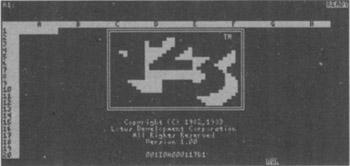The Lotus 1-2-3 Interface
The next great advance in user-interface technology came in 1979 from Lotus Corporation with the original 1-2-3 spreadsheet program. 1-2-3 was still controlled by a deeply hierarchical menu interface, but Lotus added its own twist to help make it the most successful piece of software ever sold up to that point, the visible hierarchical menu.
In 1979, a computer screen offered exactly 2000 characters per screen (see Figure 27-1), arranged in 25 horizontal rows of 80 characters each. 1-2-3 presented its menu horizontally along the top of the screen, where it consumed only two rows out of the 25 available. This meant that the menu could coexist on the screen with the actual spreadsheet program. Unlike the hierarchical menu programs that came before it, the user didn't have to leave a productive screen to see a menu. He could enter a menu command right where he was working in the program. This idea has been reinvented on the Web in the form of breadcrumbs, a row of links that both show the path a user has taken in the hierarchy of Web pages on a site and allows a user to navigate immediately to any level back up the chain.

Figure 27-1: The original Lotus 1-2-3, which first shipped in 1979, exhibited a remarkable new menu structure that actually coexisted with the working screen of the program. All other menu-based programs at that time forced you to leave the working screen to make menu selections. Like all great ideas, this one was invisible in foresight and obvious in hindsight.
Lotus used its new menu idiom with great abandon, creating a hierarchical menu structure of remarkable proportions. There were dozens of nodes in the menu tree, and several hundred individual choices available. Each one could be found by looking at the top line of the screen and tabbing over and down to the desired selection. The program differentiated between data for the spreadsheet and a command for the menu by detecting the presence of a backslash character (\). If the user typed a slash, the keystrokes that followed were interpreted as menu commands rather than data. To select an item on the menu, all you had to do was read it and type in its first letter preceded by a slash. Submenus then replaced the main menu on the top line.
Frequent users quickly realized that the patterns were memorable, and they didn't necessarily have to read the menu. They could just type / - s to save their work to disk. They could just type /-c-g-x to add up a column of numbers. They could, in essence, bypass the use of the menu entirely. They became power-users, memorizing the letter commands and gloating over their knowledge of obscure functions.
It seems silly now, but it illustrates a very powerful point: A good user interface enables its users to move in an ad hoc, piecemeal fashion from beginner to expert. A given power-user of 1-2-3 might be on intimate terms with a couple of dozen functions, while simultaneously being completely ignorant of several dozen others. If he has memorized a particular slash-key sequence, he can go ahead and access it immediately. Otherwise, he can read the menu to find those less-frequently used ones that he hasn't committed to memory. The importance of menus as a means of discovering and learning the functions of an interface is discussed at length later in this chapter.
But 1-2-3's hierarchical menu was hideously complex. There were simply too many commands, and every one of them had to fit into the single hierarchical menu structure. The program's designers bent over backwards to make logical connections between functions in an attempt to justify the way they had apportioned the commands in the hierarchy. In the delirium of revolutionary success and market dominance, such details were easily ignored.
As you might imagine, because of 1-2-3's success, the mid-80s were a time of widespread 1-2-3 cloning. The always-visible, hierarchical menu found its way into numerous programs, but the idiom was really the last gasp of the character-based user interface in the same way that the great, articulated steam locomotives of the late 1940s were the final, finest expression of a doomed technology. As surely as diesel locomotives completely eliminated all steam power within the span of a decade, the GUI eliminated the 1-2-3-style hierarchical menu within a few short years.
|
|
EAN: N/A
Pages: 263